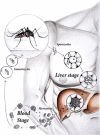Protective immunity to liver-stage malaria
- PMID: 27867517
- PMCID: PMC5099428
- DOI: 10.1038/cti.2016.60
Protective immunity to liver-stage malaria
Abstract
Despite decades of research and recent clinical trials, an efficacious long-lasting preventative vaccine for malaria remains elusive. This parasite infects mammals via mosquito bites, progressing through several stages including the relatively short asymptomatic liver stage followed by the more persistent cyclic blood stage, the latter of which is responsible for all disease symptoms. As the liver acts as a bottleneck to blood-stage infection, it represents a potential site for parasite and disease control. In this review, we discuss immunity to liver-stage malaria. It is hoped that the knowledge gained from animal models of malaria immunity will translate into a more powerful and effective vaccine to reduce this global health problem.
Figures

Similar articles
-
Malaria vaccines: identifying Plasmodium falciparum liver-stage targets.Front Microbiol. 2015 Sep 15;6:965. doi: 10.3389/fmicb.2015.00965. eCollection 2015. Front Microbiol. 2015. PMID: 26441899 Free PMC article. Review.
-
Malaria vaccine.Indian J Pathol Microbiol. 1996 Dec;39(5):433-41. Indian J Pathol Microbiol. 1996. PMID: 9002371
-
Parasite Recognition and Signaling Mechanisms in Innate Immune Responses to Malaria.Front Immunol. 2018 Dec 19;9:3006. doi: 10.3389/fimmu.2018.03006. eCollection 2018. Front Immunol. 2018. PMID: 30619355 Free PMC article. Review.
-
Pathways and strategies for developing a malaria blood-stage vaccine.Annu Rev Immunol. 1998;16:57-87. doi: 10.1146/annurev.immunol.16.1.57. Annu Rev Immunol. 1998. PMID: 9597124 Review.
-
Protective immunity to pre-erythrocytic stage malaria.Trends Parasitol. 2011 Jul;27(7):306-14. doi: 10.1016/j.pt.2011.02.002. Epub 2011 Mar 23. Trends Parasitol. 2011. PMID: 21435951 Review.
Cited by
-
Targeting liver stage malaria with metformin.JCI Insight. 2019 Dec 19;4(24):e127441. doi: 10.1172/jci.insight.127441. JCI Insight. 2019. PMID: 31852843 Free PMC article.
-
Innate immunity limits protective adaptive immune responses against pre-erythrocytic malaria parasites.Nat Commun. 2019 Sep 2;10(1):3950. doi: 10.1038/s41467-019-11819-0. Nat Commun. 2019. PMID: 31477704 Free PMC article.
-
Plasmodium's fight for survival: escaping elimination while acquiring nutrients.Trends Parasitol. 2022 Jul;38(7):544-557. doi: 10.1016/j.pt.2022.04.004. Epub 2022 May 6. Trends Parasitol. 2022. PMID: 35534377 Free PMC article. Review.
-
Immune gene expression changes more during a malaria transmission season than between consecutive seasons.Microbiol Spectr. 2024 Oct 3;12(10):e0096024. doi: 10.1128/spectrum.00960-24. Epub 2024 Aug 20. Microbiol Spectr. 2024. PMID: 39162546 Free PMC article.
-
Hepatitis B Virus Infection: A Mini Review.Viruses. 2024 May 3;16(5):724. doi: 10.3390/v16050724. Viruses. 2024. PMID: 38793606 Free PMC article. Review.
References
-
- WHO. World malaria report 2015. 2015. (ISBN: 978 92 4 156515 8).
-
- Coatney GR, Collins WE, Warren M, Contacos PG. The PrimateMalarias: U.S. National Institute of Allergy and Infectious Diseases: Bethesda, MD, USA, 1971.
Publication types
LinkOut - more resources
Full Text Sources
Other Literature Sources
Research Materials
